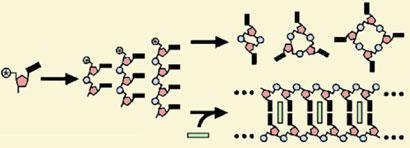'Molecular midwives' may have helped the first DNA strands form in the primordial soup
US researchers have uncovered new clues to how the earliest forms of life may have evolved in the primordial soup. The secret could be ’molecular midwives’ - compounds that played a crucial role in combining small nucleotide fragments into the first genetic polymeric material.
’There are lots of unanswered questions about the how the first genetic polymers formed on the prebiotic Earth - that is, without the protein enzymes that are around today,’ says Nicholas Hud, who led the research at the Georgia Institute of Technology. ’We investigated how small nucleotide fragments might have joined together in long polymers - forming the first DNA or RNA strands.’
One problem with examining how DNA first formed is that small chains of nucleotides - around three or four bases long - are flexible enough to bond with themselves. Therefore they favour intramolecular bonding, and tend to curl up and cyclise, forming small rings rather than a long chain.

Now, Hud’s team have found that the presence of certain compounds can stabilise a growing strand of DNA. The compounds are known as intercalators - large flat molecules that can slide between the bases in DNA like wooden planks - holding the structure in place with non-covalent interactions. The compounds have been termed midwife molecules by the team, since once the polymer is formed they are no longer needed.
Two examples of midwife molecules are ethidium and coralyne - large, multiringed organic compounds, but it is unlikely that either of these was the very first midwife. ’Our work suggests that there might be been a planar midwife molecule involved in the very beginnings of life on Earth,’ Hud says. ’But it remains unidentified, and may not even still be around.’
One intriguing prospect is that the first midwife molecule was responsible for selecting the base-pairing combinations of adenine-thymine (A-T) and cytosine-guanine (C-G) that make up DNA. While ethidium was found to stabilise the traditional Watson-Crick pairing, the azacyanine aza3 was found to stabilise an alternative system where adenine binds to adenine (A-A).
’Different midwife molecules can be selective to different systems of base pairing,’ Hud says. ’Our hypothesis is that the original midwife molecule helped select which base pairs were used in DNA.’
’This study shows very nicely that a combination of nucleic acids and structurally unrelated molecules is more likely to produce a self-replicating system - and thus life - than nucleic acids alone,’ says Clemens Richert, an expert in DNA at the University of Stuttgart, Germany.
Lewis Brindley
References
E Horowitz et al, Proc. Natl. Acad. Sci. USA, 2010, DOI: 10.1073/pnas.0914172107






No comments yet